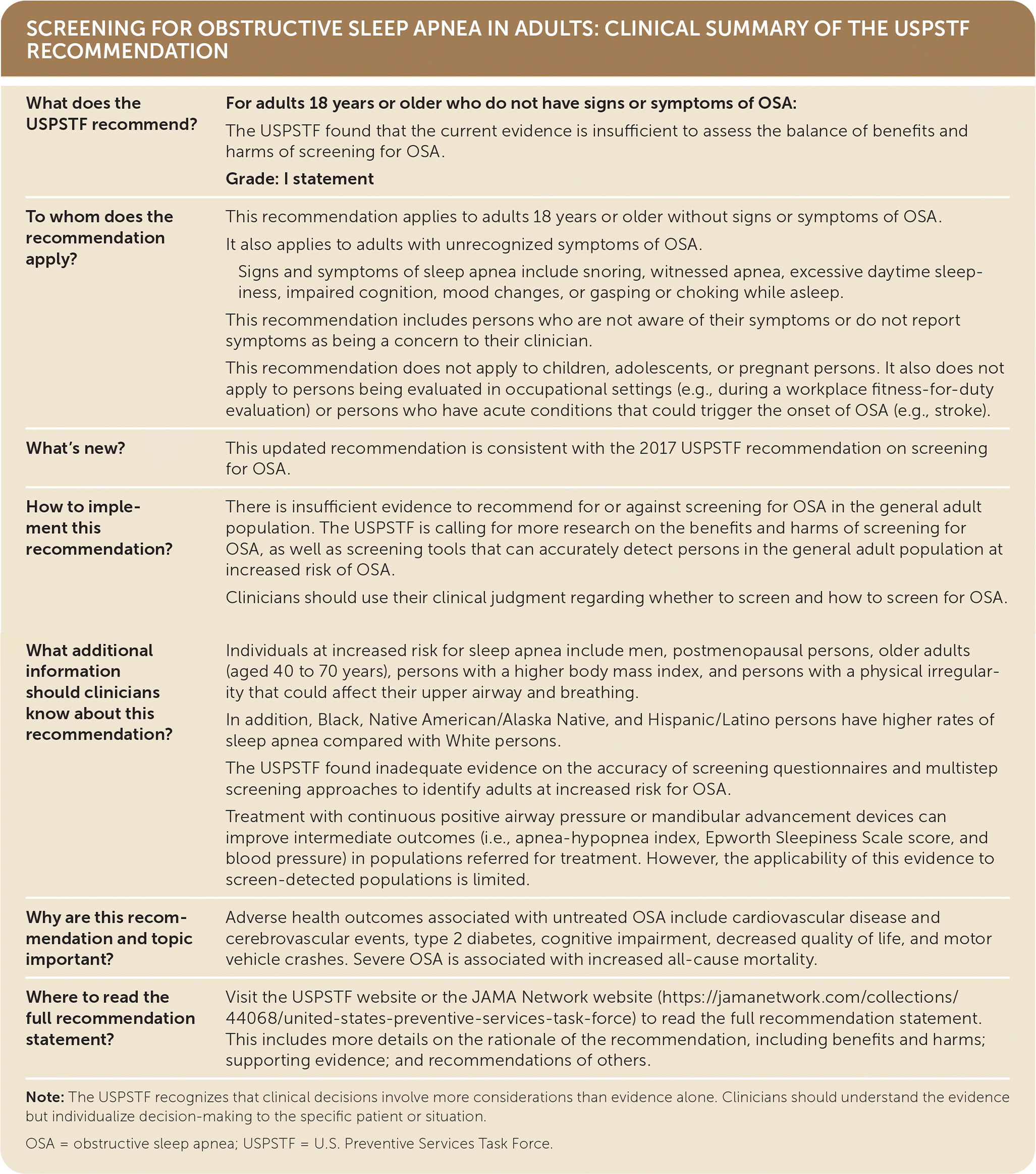
Am Fam Physician. 2023;107(3):online
Related Putting Prevention Into Practice: Screening for Obstructive Sleep Apnea in Adults
As published by the USPSTF

| What does the USPSTF recommend? | For adults 18 years or older who do not have signs or symptoms of OSA: The USPSTF found that the current evidence is insufficient to assess the balance of benefits and harms of screening for OSA. Grade: I statement |
| To whom does the recommendation apply? | This recommendation applies to adults 18 years or older without signs or symptoms of OSA. It also applies to adults with unrecognized symptoms of OSA. Signs and symptoms of sleep apnea include snoring, witnessed apnea, excessive daytime sleepiness, impaired cognition, mood changes, or gasping or choking while asleep. This recommendation includes persons who are not aware of their symptoms or do not report symptoms as being a concern to their clinician. This recommendation does not apply to children, adolescents, or pregnant persons. It also does not apply to persons being evaluated in occupational settings (e.g., during a workplace fitness-for-duty evaluation) or persons who have acute conditions that could trigger the onset of OSA (e.g., stroke). |
| What’s new? | This updated recommendation is consistent with the 2017 USPSTF recommendation on screening for OSA. |
| How to implement this recommendation? | There is insufficient evidence to recommend for or against screening for OSA in the general adult population. The USPSTF is calling for more research on the benefits and harms of screening for OSA, as well as screening tools that can accurately detect persons in the general adult population at increased risk of OSA. Clinicians should use their clinical judgment regarding whether to screen and how to screen for OSA. |
| What additional information should clinicians know about this recommendation? | Individuals at increased risk for sleep apnea include men, postmenopausal persons, older adults (aged 40 to 70 years), persons with a higher body mass index, and persons with a physical irregularity that could affect their upper airway and breathing. In addition, Black, Native American/Alaska Native, and Hispanic/Latino persons have higher rates of sleep apnea compared with White persons. The USPSTF found inadequate evidence on the accuracy of screening questionnaires and multistep screening approaches to identify adults at increased risk for OSA. Treatment with continuous positive airway pressure or mandibular advancement devices can improve intermediate outcomes (i.e., apnea-hypopnea index, Epworth Sleepiness Scale score, and blood pressure) in populations referred for treatment. However, the applicability of this evidence to screen-detected populations is limited. |
| Why are this recommendation and topic important? | Adverse health outcomes associated with untreated OSA include cardiovascular disease and cerebrovascular events, type 2 diabetes, cognitive impairment, decreased quality of life, and motor vehicle crashes. Severe OSA is associated with increased all-cause mortality. |
| Where to read the full recommendation statement? | Visit the USPSTF website or the JAMA Network website (https://jamanetwork.com/collections/44068/united-states-preventive-services-task-force) to read the full recommendation statement. This includes more details on the rationale of the recommendation, including benefits and harms; supporting evidence; and recommendations of others. |
The full recommendation statement is available at https://www.uspreventiveservicestaskforce.org/uspstf/recommendation/obstructive-sleep-apnea-in-adults-screening.
The USPSTF recommendations are independent of the U.S. government. They do not represent the views of the Agency for Healthcare Research and Quality, the U.S. Department of Health and Human Services, or the U.S. Public Health Service.
